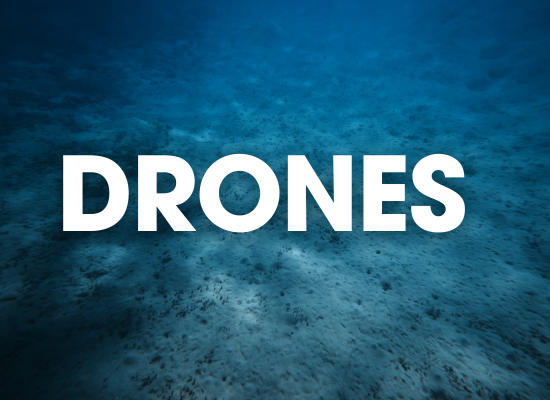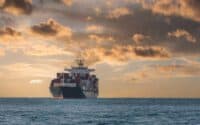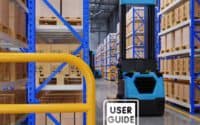Drones in Commercial Shipping: A Revolution at Sea

For shipowners looking to embrace the next wave of innovation, drones present an exciting frontier. These unmanned aerial vehicles, once associated mainly with military operations or hobbyist activities, are now making significant strides in commercial shipping. The advantages they bring are manifold, offering solutions that are not just cutting-edge but also economically and operationally beneficial. Let’s take a look at 12 potential and current use cases of drones in commercial shipping.
* Please send feedback/suggestions to editor @ shipuniverse.com
Use 1: Inspection and Maintenance
Modern ship maintenance and inspections aren’t just about crew members with checklists. Advanced technologies like drones are changing the game, especially in the following aspects:
Underwater Inspection: Marine environments are harsh, and over time, the submerged parts of a ship are subject to wear, tear, and fouling. Underwater drones or ROVs bring forth several advantages:
- Detailed Examination: With high-definition cameras and sonar systems, ROVs can capture detailed imagery of ship parts submerged in water, making it easier to spot damages or anomalies.
- Safety and Efficiency: Traditionally, divers would carry out these inspections, but ROVs can cover vast areas more quickly without risking human lives.
- Fouling Assessments: By detecting early signs of biofouling, shipowners can schedule clean-ups, ensuring smoother vessel operations and reduced fuel costs.
Inventory Management: A ship’s inventory, especially for large vessels, can be expansive. Drones streamline the monitoring process in the following ways:
- Quick Audits: Automated drones can be programmed to fly over storage areas, capturing images of stored items and their conditions, facilitating quicker audits.
- Real-time Data: By integrating with inventory management software, discrepancies can be spotted in real-time, ensuring timely reorders or adjustments.
- Safety: Some equipment might be stored in hard-to-reach places; drones eliminate the need for crew members to access potentially hazardous locations.
Use 2: Cargo Monitoring and Security
Cargo is the lifeblood of commercial shipping. Ensuring its safety, security, and integrity is paramount. Drones assist in these areas with unprecedented efficiency:
Cargo Temperature Monitoring: Certain cargoes, especially perishable goods, demand strict temperature controls. Drones equipped with thermal sensors offer:
- Real-time Monitoring: Quick scans of cargo holds or containers to ensure consistent temperature levels.
- Anomaly Detection: Early identification of hotspots or areas where temperature deviates from the norm, allowing immediate corrective actions.
- Data Logging: Consistent monitoring ensures adherence to compliance standards and can be used for dispute resolutions.
Crowd Control: For vessels that carry passengers, managing crowds efficiently is crucial. Drones aid in:
- Surveillance: Aerial perspectives give a clear view of passenger flow, ensuring no overcrowded areas.
- Emergency Management: In case of emergencies, drones can guide evacuation processes by providing real-time footage to security personnel, ensuring safe and orderly evacuations.
- Queue Management: For boarding and disembarkation, drones can identify and relay information on bottleneck areas, facilitating smoother passenger movement.
Use 3: Environmental Compliance and Monitoring
The environmental footprint of ships is under constant scrutiny. Drones play a crucial role in ensuring eco-friendly operations:
Waste Management: Proper waste disposal is both a regulatory requirement and an environmental responsibility. Drones aid in:
- Monitoring: Drones can oversee waste disposal activities, ensuring they are conducted as per guidelines.
- Documentation: With cameras, drones can document the process, providing evidence of compliance with environmental standards.
- Spill Detection: In case of accidental spills, drones can quickly identify affected areas, enabling swift containment actions.
Biofouling Surveillance: Marine biofouling can be detrimental, not just to ships but also to marine ecosystems when invasive species are transported. Drones help in:
- Early Detection: Regular hull checks can identify early stages of biofouling, enabling timely cleaning.
- Species Identification: Advanced drones equipped with sampling tools can identify species, assisting in environmental studies.
- Operational Efficiency: A clean hull free from biofouling ensures optimal ship performance and reduced fuel consumption.
Use 4: Navigation and Route Planning
Obstacle Detection: Navigating through congested waterways or approaching unfamiliar ports can be daunting. The presence of submerged obstacles, debris, or even smaller vessels can pose significant risks. Drones, equipped with high-definition cameras and sonar systems, provide a bird’s-eye view of the ship’s intended route, allowing navigators to:
- Spot and identify obstacles in real-time, sending immediate alerts to the crew.
- Create a ‘live map’ of the area, with potential hazards clearly marked out, helping the crew in real-time decision-making.
- Facilitate in docking maneuvers, giving a clearer perspective of the ship’s position relative to the dock.
Ice Surveillance: Navigating polar regions can be treacherous. Traditional methods of ice surveillance often rely on satellite imagery, which might not be updated in real-time. Drones offer a more immediate solution:
- Equipped with thermal and infrared sensors, drones can determine the thickness and stability of ice formations.
- Real-time footage can help the ship’s crew to determine the safest passage, avoiding areas where ice might pose a risk.
- Continuous monitoring ensures that the ship doesn’t get trapped in shifting ice formations, especially in regions where conditions change rapidly.
Use 5: Search and Rescue Operations
Overboard Recovery: Every minute counts when a person is overboard. While ships are equipped with lifebuoys and alarms, locating the individual in vast expanses of water is challenging. Drones revolutionize this process by:
- Offering rapid deployment, covering large areas in a short span.
- Using thermal imaging to pinpoint the exact location of the person, even in low-visibility conditions.
- Providing real-time footage back to the ship, aiding in rescue coordination and ensuring that the rescue boat reaches the individual without delay.
Emergency Supplies Delivery: There are situations, such as a ship being grounded or a crew member being injured, where immediate assistance is required. However, rough seas or other obstacles might prevent the vessel from getting close. Drones come to the rescue by:
- Carrying essential supplies like medicines, communication devices, or first aid kits directly to the distressed vessel or individual.
- Ensuring that help reaches those in need even when helicopters or boats can’t be deployed immediately, potentially saving lives.
Use 6: Communication and Connectivity
Signal Boosting: Communication is vital when at sea. However, there are zones where signals might be weak or non-existent. Drones equipped with relay technology can serve as temporary communication boosters by:
- Being deployed to higher altitudes, catching stronger signals and relaying them back to the ship.
- Offering an immediate solution in areas where satellite communication faces disruptions, ensuring that the ship remains connected at all times.
Document Delivery: Bureaucratic processes at harbors can sometimes lead to delays, especially if essential documents need to be physically transported between the ship and the port authorities. Drones optimize this process by:
- Providing a swift mode of transport, ensuring that documents reach the intended recipients in the shortest possible time.
- Reducing the need for smaller boats to ferry these documents, leading to time and cost savings.
- Ensuring that clearance processes are expedited, leading to quicker docking and unloading.
The diverse functionalities of drones, from enhancing safety to boosting communication, position them as invaluable assets in the maritime domain. For shipowners and operators, the integration of drone technology represents not just an embrace of modernity but a commitment to efficiency, safety, and operational excellence.
Use 7: Emergency Response and Firefighting
Fire Detection: The initial moments during a fire breakout are crucial. Rapid detection can make the difference between a minor incident and a major catastrophe.
- Early Warning: With thermal cameras, drones can swiftly scan the entire ship’s structure, detecting heat anomalies indicative of a fire even before visible smoke appears.
- Access to Challenging Locations: Drones can quickly reach areas that might be inaccessible or dangerous for crew members, such as cargo holds or engine rooms.
- Data Logging: Continuous monitoring allows for a recorded history of the incident, aiding in subsequent investigations and corrective actions.
Firefighting Assistance: While drones aren’t a replacement for comprehensive firefighting systems, they offer quick initial response capabilities.
- Direct Attack: Drones equipped with fire retardants can directly target the source of the fire, slowing its spread.
- Guided Response: By providing real-time visuals, drones can guide the ship’s firefighting crew, ensuring they are well-informed before engaging the fire directly.
- Safety: In situations where it’s too dangerous for crew members to approach, drones can act as an initial response until more extensive measures can be put into place.
Use 8: Crew Training and Drills
Monitoring Drills: Safety drills are a regulatory requirement and crucial for the crew’s preparedness. Drones provide an added layer of oversight and analysis.
- Objective Feedback: An aerial perspective offers a complete view of the drill, capturing details that might be missed at the deck level.
- Performance Analysis: Post-drill, the footage can be reviewed to assess response times, coordination, and adherence to safety protocols, providing valuable feedback for improvement.
- Documentation: In terms of compliance, recorded drone footage can serve as evidence that drills were conducted as per maritime regulations.
Simulation: Realistic training scenarios are essential for ensuring the crew’s readiness. Drones can enhance the realism of these drills.
- Dynamic Scenarios: Drones can drop dummies to simulate man-overboard situations, providing real-time practice for the crew.
- Mock Fire Sources: Drones equipped with smoke generators can simulate fires at various ship locations, testing the crew’s response agility.
- Variable Challenges: With programmable flight paths, drones can simulate different emergency scenarios in successive drills, ensuring the crew is prepared for a range of situations.
Use 9: Ship-to-Ship Operations
Transfer Coordination: Whether for refueling, cargo transfers, or equipment exchanges, coordination between ships is paramount for safety and efficiency.
- Situational Awareness: Drones can provide live aerial footage, giving both vessels a clear understanding of their relative positions and movements.
- Hazard Detection: Before initiating transfers, drones can scout the area for potential hazards like debris, ensuring a safe operational environment.
- Guided Operations: Real-time visuals can guide the crew during intricate operations, minimizing the risk of collisions or equipment damage.
Delivery between Ships: In the vast expanse of the sea, even nearby vessels can seem far away. Drones bridge this gap with rapid delivery capabilities.
- Swift Exchanges: For essential documents, replacement parts, or emergency medicine, drones can ensure delivery within minutes.
- Safety: Eliminating the need for smaller boats to traverse between ships, especially in rough seas, drones offer a safer alternative.
- Cost-Efficient: Drones, especially for short-distance deliveries, can be more fuel-efficient and cost-effective compared to deploying boats or helicopters.
Use 10: Energy Efficiency Analysis
Assessing Propulsion Efficiency: Understanding how efficiently a ship moves through water is crucial for both fuel savings and performance optimization.
- Flow Visualization: Drones can capture real-time videos of water flow around the hull and propeller, highlighting areas of excessive turbulence or inefficient flow.
- Benchmarking: By collecting data over time, drones can help establish benchmarks for optimal performance, allowing ship operators to identify when propulsion systems might need maintenance or tuning.
- Fouling Identification: Over time, ship hulls can become fouled, leading to increased drag and decreased efficiency. Drones can visually inspect hull conditions, prompting timely clean-ups.
Solar Panel Inspection: For eco-conscious shipping, solar panels are a significant addition. Ensuring they operate optimally is vital.
- Panel Health Checks: Drones equipped with specific sensors can assess the solar panel’s health, identifying malfunctioning or sub-optimal cells.
- Debris Detection: Dust, seagull droppings, and other debris can reduce the efficiency of solar panels. Drones can quickly survey the panels, recommending when a cleanup might be needed.
- Angle and Alignment: For ships with adjustable solar panels, drones can help in determining the optimal angle and alignment for maximum sunlight capture.
Use 11: Surveillance and Anti-Piracy
Perimeter Scouting: In certain waters, the threat of piracy is real. Proactive surveillance can deter potential threats.
- Continuous Monitoring: Drones can patrol the ship’s perimeter continuously, especially during night-time or when sailing through high-risk areas.
- Infrared Imaging: Equipped with IR cameras, drones can detect heat signatures even in total darkness, providing a round-the-clock surveillance capability.
- Deterrence: The mere presence of an active drone can act as a deterrent to potential pirates, signaling the ship’s preparedness.
Evidence Gathering: Documentation can be crucial for legal, insurance, and security analysis purposes.
- High-Resolution Capture: Modern drones come with high-definition cameras capable of capturing minute details, vital for forensic analysis.
- Timestamps and Geo-tagging: Drones can provide time-stamped and location-tagged videos, offering undeniable evidence in case of disputes.
- Protected Storage: Advanced drones can transmit their footage in real-time to the ship’s secure servers or cloud storage, ensuring evidence isn’t lost even if the drone is captured or destroyed.
Use 12: Weather Monitoring and Reporting
Weather Data Collection: Being at the mercy of the elements, ships benefit enormously from accurate, localized weather data.
- Micro-climate Analysis: Drones can measure temperature, humidity, wind speed, and more in the immediate vicinity of the ship, offering insights into micro-climatic conditions.
- Sea State Assessment: By flying low over the water, drones can help gauge wave heights and frequencies, vital for navigation and stability decisions.
- Cloud Studies: Drones can also be sent vertically upwards to study cloud formations and altitudes, providing early warnings of developing weather phenomena.
Storm Tracking: Navigating around storms is not only safer but also more fuel-efficient.
- Storm Proximity: Drones can be dispatched towards visible storm systems to assess their distance and scale without endangering the ship.
- Trajectory Analysis: By monitoring the movement of storms over time, drones can help plot their paths, allowing ships to adjust routes proactively.
- Visual Alerts: Real-time footage from drones can be broadcasted onboard, offering visual cues to the crew about the impending weather, aiding in preparation and decision-making.
The versatility of drones in these scenarios underscores their potential in revolutionizing maritime operations, enhancing both efficiency and safety.

Do you have a Maritime Product or Service that may be of interest to Shipowners? Tell us about it here!
Do you have feedback or insights? Please reach out to editor @ shipuniverse.com



